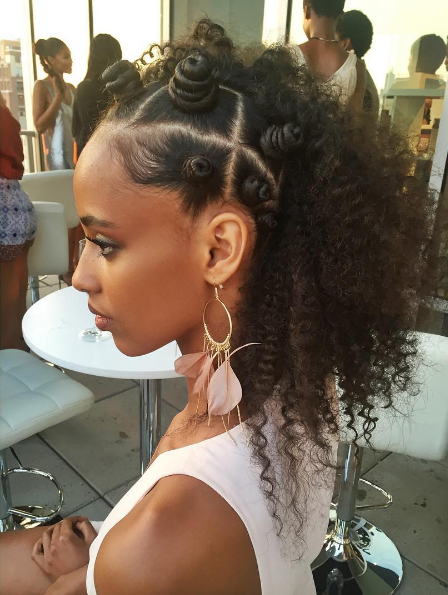Beauty Vlogger Learns What Bantu Knots Are the Hard Way
Norwegian beauty vlogger Gilan Sharafani just caught a ton of flack on social media for a tutorial she posted on how to get heatless curls. In the video, the beauty guru demonstrates what is commonly known as a Bantu knot-out, in which you twist your hair into a series of small buns before taking them out to reveal oodles of curls. It is a method often used by black women to add curl definition, and Bantu knots are a hairstyle that dates centuries back to the Zulu tribes, who rocked them long before Sharafani filmed the controversial video.
Commenters quickly took Sharafani to task for not doing her research, as well as failing to call the hairdo by its actual name. Many also discussed the trend in mainstream culture where hairstyles commonly and historically worn by black women are considered unattractive (or, in this case, nonexistent) until non-black women decide to try them out.
As one commenter @maneobjective pointed out, the problem isn’t that Sharafani did a Bantu knot-out — she’s free to experiment with her hair as she pleases. The issue is that this hairstyle already has a name that most people know, and it should be called what it is. “This is about black women being absolutely fed up and tired of having their cultures, styles, and body parts mimicked and appropriated,” a commenter explained. “We all learned in school that when you use someone else’s words or ideas, you cite your sources. Why is that concept so hard to apply here? Why is everyone so against us asking her or anyone else to cite their sources? Why is there so much resistance? Whether she did the style right or not, whether it looks terrible or not, is of no consequence to me. Just cite your sources, don’t play coy/passive aggressive, take your video, and move on.”
A similar issue arose when the “boxer braids” trend took over the Internet a few months ago. The style, which has been worn by women for centuries, is commonly referred to as cornrows or Dutch braids, depending on who you ask and how you style it. And Refinery 29’s Short Cuts recently got some pushback over its “rope braid” video tutorial, which shows a simple two-strand twist — another hairstyle worn mostly by black women.
Rebranding a traditional hairstyle as something fresh and new without any regard for the people who have been using it, or doing even minimal research to see if it already has a name and a history, is quite a common thing in the fashion and beauty world. While we can’t all be supersleuths, if people can do research to find out where the LBD originated, surely they can find out what a two-strand twist is before putting out a tutorial. Why do these styles need to be rebranded at all?

A beautiful half-Bantu ‘do. Photo (@Mizaniusa)
Sharafani claimed she used the “heatless curls” title out of ignorance, once commenters called her out on it. “For all of you commenting about what I [shall] call this style, I did not know that this was an African hairstyle TILL now! And I have never said that this is a new [technique discovered] by me! So if you want me to call it Bantu knots, then it’s Bantu knots.” Sharafani still appeared to be missing the point — it’s not called Bantu knots because of some random whim of black women — it’s called Bantu knots because that’s what they are. And maybe, just maybe, she should consider using the proper nomenclature for something if she wants to be considered a credible guru.
Later, Sharafani relented, adding a note to the original video:
“After that, I shared this video on my Instagram, ppl started telling me that the [technique] I was using was from Africa - WHICH IS [called] Bantu knots. I [didn’t know] that, till everyone [started] commenting about that. If knew from the start that this [technique] was African, I would for sure call it Bantu knots. So, Bantu knots is really one of the best [technique] to get curly hair with no heat!”
We keep seeing these missteps happening in the fashion and beauty world — this publication included. But it’s high time we all educated one another. The fact of the matter is, in an age where information is so accessible and can be shared at the blink of an eye, cultures, as they have done for centuries, are going to mix, meld, mesh, and transform. And that’s OK! But it is just as important to understand where these things come from, especially since we live in a society that has blatantly ripped off and mocked traditions from other cultures, only for them to be later adopted by the dominant society without giving any credit.
If Sharafani genuinely didn’t know she was doing a Bantu knot-out, those who do know should inform her in a constructive way. Also, if you’re going to call yourself a beauty expert, it’s important to learn about beauty in all forms. If someone has a genuine interest in hair, why wouldn’t she explore how people with different textures take care of their own and draw inspiration from that? A lapse in judgment and a failure to do research brought Sharafani’s credibility into question. Yet, all of this could have been avoided if she were more diligent and curious as to where this hairstyle originated.
Let’s keep in touch! Follow Yahoo Beauty on Facebook, Twitter, Instagram, and Pinterest.
